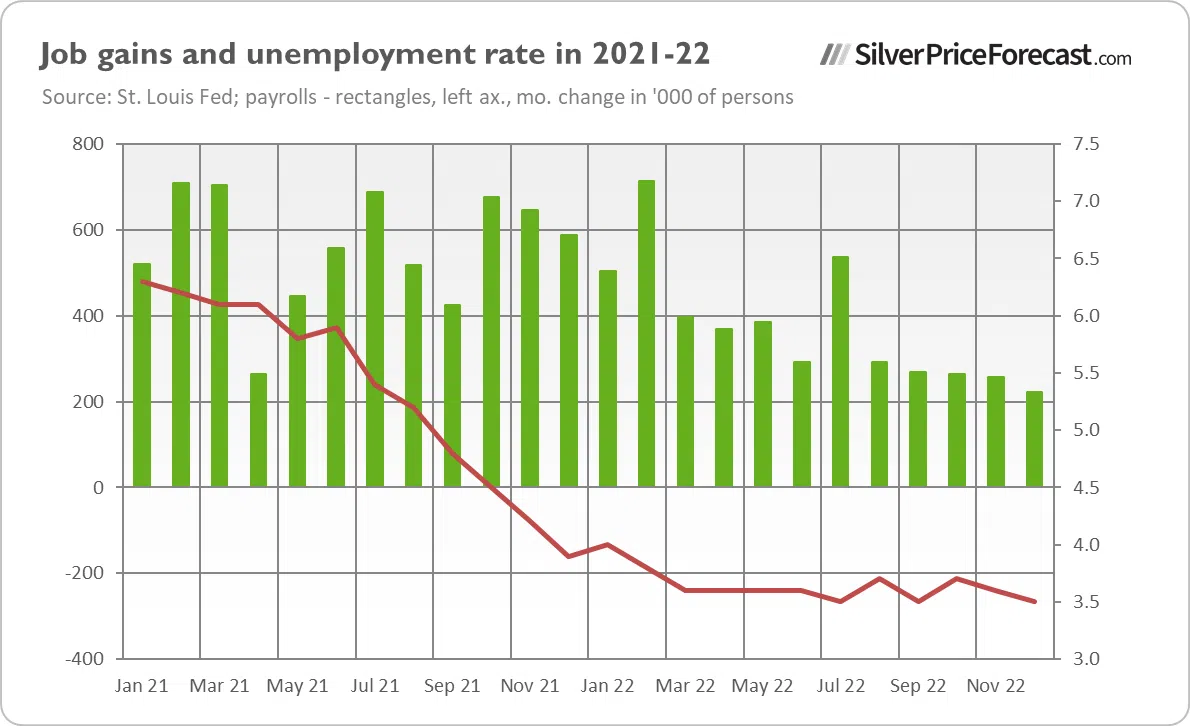Bearish Payrolls? No Problem, Silver Continues Its Rising Trend
The labor market remains strong. Even though this is bad new for silver on the fundamental front, it continues its upward trend started in November.
The US labor market added 223,000 jobs in December, according to the BLS (see the chart below). The number was lower than in November (+256,000) but exceeded expectations (+200,000). The job growth has averaged 375,000 in 2022, much less than the average monthly gain of 562,000 seen in 2021. However, it was still above the level needed to put all eager people to work. And please remember that all these job gains came amid the very aggressive Fed’s tightening cycle. Last but not least, the unemployment rate declined from 3.6% to 3.5%, as the chart below shows. Hence, the U.S. labor market showed great resilience during the Fed’s jumbo hikes in the federal funds rate seen last year.

Strong Labor Market Implies Hawkish Fed
From the fundamental perspective, higher-than-expected nonfarm payrolls and a decline in the unemployment rate in December are bad news for the precious metals. A softer slowdown in employment growth means that the Fed is likely to remain hawkish for longer, achieving a possibly higher terminal rate. After all, the strong labor market gives the US central bank room to continue its tightening of monetary policy. Hence, I still expect another 50-basis point hike in the nearest FOMC meeting instead of the expected 25-basis points move. Until recessionary pressure intensifies and the labor market starts showing concrete signs of weakness, pushing the Fed more into the dovish side, the $25 could remain out of reach for silver.
Implications for Silver
What does it all mean for the silver outlook for 2023? Well, the initial reaction of the precious metals was surprisingly positive. The price of gold went up from $1,840 to $1,870, while the price of silver jumped from $23.4 to $23.8, with a short correction on the way. It implies that silver reacted relatively bullish in face of a rather bearish employment report. Hence, the bull trend that started in November 2022 (see the chart below, courtesy of silverpiceforecast.com) could continue.

However, one caveat is proper. It seems that traders focused on the slowdown in the job gains, using it as an excuse to bet on a 25-basis point hike in early February. But the slowdown was softer than expected, and it’s not clear that it will affect the Fed’s stance and prompt the FOMC to deliver a 25-basis-point hike instead of a half-percentage move. I’m bullish on the precious metals in 2023, but I don’t see too many bullish signals in the latest employment report.
What are your thoughts on this subject? Don’t hesitate to share in the comments!
Arkadiusz Sieron, PhD